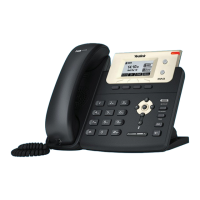Administrator’s Guide for SIP-T2 Series/T19(P) E2/T4 Series/T5 Series/CP860/CP920 IP Phones
100
To configure VPN via phone user interface after uploading a TAR file:
1. Press Menu->Advanced (default password: admin) ->Network->VPN.
2. Press or , or the Switch soft key to select the desired value from the VPN
Active field.
You must upload the OpenVPN TAR file using configuration files or via web user interface
in advance.
3. Press the Save soft key to accept the change.
A dialog box pops up to prompt that the settings will take effect after a reboot.
4. Click OK to reboot the phone.
Network Address Translation (NAT)
Network Address Translation (NAT) is one of the technologies for solving the network problem
– the shortage of IP addresses. Many countries provide only one public IP address for complete
companies. They configure NAT to advertise the IP address for the entire network to the
outside world. This can reduce the need for a large number of public IP addresses.
NAT is essentially a translation table that maps public IP address and port combinations to
internal private ones. NAT ensures security since each outgoing or incoming request must first
go through a translation process.
NAT Types
Symmetrical NAT
In symmetrical NAT, the NAT router stores the address and port where the packet was sent.
Only packets coming from this address and port are forwarded back to the private address.
Full Cone NAT
In full cone NAT, all packets from a private address (e.g., iAddr: port1) to public network will be
sent through a public address (e.g., eAddr: port2). Packets coming from the address of any
server to eAddr: port2 will be forwarded back to the private address (e.g., iAddr: port1).
